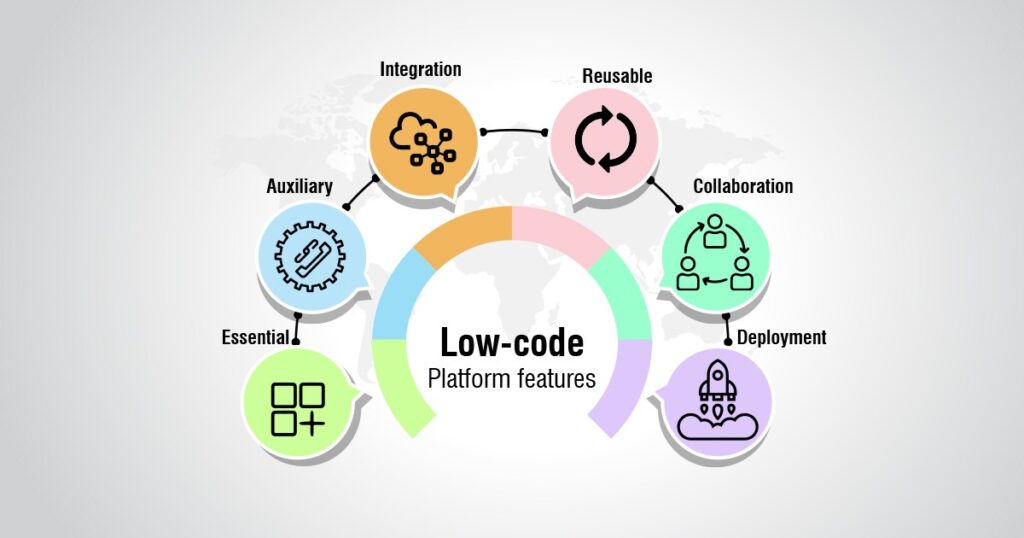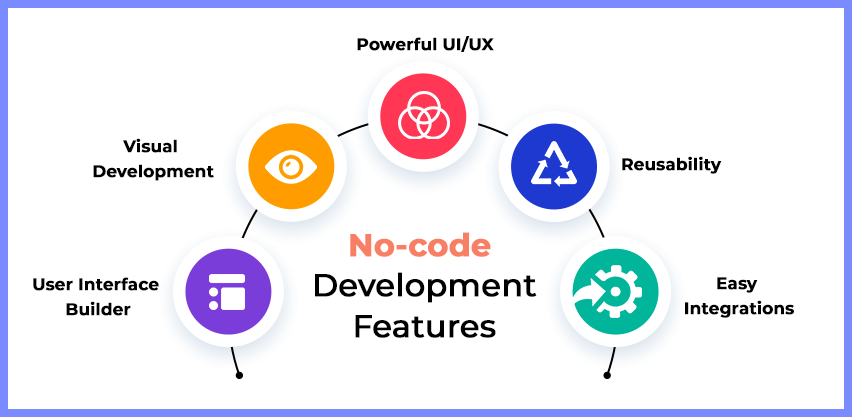
The Explosion Behind the Low Code and No Code Solutions
Are you a developer who is obsessed with code or programming lines? Have you worked too much on the coding part that code lines actually came in your dreams?
Well, if your answer is no, then you are lucky enough. Otherwise, we have something to share with you.
In this technology-driven world, your hard-earned programming skills may become obsolete soon, but on the other hand, the entire programming process may become a cakewalk, allowing you to build more digital products in a short time.
Low code and no code platforms and applications are gaining a lot of attention for many organizations in the digital workplace.
But if you are a CTO, there is also good news for you.
A report from Gartner says that many organizations in the market will use low code and no code development platforms to create 70% of new applications by 2025.
The advent of low code development platforms is fueling citizen developers as well as the rise of business leaders who work outside of IT departments to develop technology or analytics capabilities for business usage.
As a result, it forces us to shift the way applications are developed. Thus, the focus will shift from application development to integration and assembly, with teams that use them composing and assembling them. In fact, as per the prediction by Gartner, the number of applications created in low code development platforms is likely to increase more than 70%.
Therefore, every developer has shifted their focus to develop an application with Low code/No code platforms. At the same time, CTOs and CIOs are keeping an eye on Low code/No code platforms for the great success of their business.
So, let’s understand each platform individually.
Read Also- E-Commerce Trends 2022 That Add Values to Magento 2 Store
Low Code Platforms

A Low code development platform is one of the intuitive approaches where you would require a bit of no coding for developing applications. It allows you to create an app using drag-and-drop functionality and logic-driven graphical interfaces instead of writing infinite lines of code with complex programming languages.
A report from Mendix states that low code development is a visual method to software development. In addition, low code development platforms abstract and automate every development lifecycle step, allowing for rapid deployment and delivery of many software solutions.
As per the Forrester report, the low code market will increase at a 40% annual growth, with spending expected to reach $21.2 billion by 2022.
Read Also- Samsung Galaxy S22 rumours: release date, price, specs and more
No Code Platforms

A no code development platform is designed to help non-technical people craft applications without using large code lines.
Furthermore, KissFlow – one of the renowned no code platforms, explains: A no code app development is a development platform that utilizes a visual development environment, allowing anyone to build software applications in a short time. Moreover, it also offers various functionalities like drag-and-drop, pre-defined components, and many others, allowing an easy development process.
In a nutshell, no code app development can be done without having any coding knowledge.
Low Code/No Code Platforms
While talking about no code low code platforms, these are visual development environments, enabling you to build apps or websites with the help of graphical user interfaces, but not program coding. They simply adhere to the simplicity of development and ease of use. Moreover, you don’t need any extra coding lines in addition to implementing some specific features or functionalities.
The low code no code platforms come up with many options, ranging from creating an application from scratch to managing the content on a daily basis without the involvement of developers. Well, you can consider this in-between content management and development.
Suppose you want to create a landing page for your website in a series of short and intuitively understandable steps.
You have the freedom to use numerous libraries, templates, pre-defined functions, WYSIWYG editors, customized elements, drag-and-drop elements, and many more features to use a low code no code platform.
Read Also- Progressive Web Apps for eCommerce – Everything You Need to Know
Citizen Developers: Who are They?
Gartner was the first organization that introduced the “Citizen Developer” term.
Citizen developers are employees who can develop websites or web apps using low code development platforms and no code development platforms without having any formal training in software development.
The official definition of Citizen Developer is,
“A citizen developer is an employee who creates application capabilities for consumption by themselves or others, using tools that are not actively forbidden by IT or business units.”
In fact, citizen developer is not a job profile. It’s actually the capabilities and skills that cater to the user persona. Well, this could be anyone of you with less technical skills and knowledge. In the Gartner company, citizen developers belong to one department except IT. They are business users, and they implement business ideas with low code/no code opportunities.
Low Code Assists in Solving the Skill Shortage
The shortage of talent and skilled developers in the technology industry has been extensively documented, and the situation has become critical for application development.
According to the study, the rise of low code app development is assisting many organizations in speeding up development by democratizing how software is produced to involve business users.
Moreover, the low code is capable of bringing major software projects back on track while reducing costs and utilizing the company’s hidden technical talent.
As per the report from Mendix State of Low Code 2021, around 77% of businesses have already implemented low code application development to meet their customer demands and requirements, and around 75% of IT executives believe it’s a trend they can’t afford to ignore. This research was based on a poll of 2025 IT professionals from six countries.
Here are some of the statistical data, which you should consider as well:
- Over 56% of employees in an organization that uses low code are now using apps created on low code platforms.
- Low code users witnessed better collaboration, faster time-to-market, and cheaper costs in two out of five cases, with low code projects reducing costs by 53% and completing 56% faster.
- Low code has been utilized to construct mission-critical apps by 33% of those organizations which use it.
- Software developers claimed that a low code platform could handle half of their daily development work, which is around 51%.
- Read Also- How Do Free App Make Money in 2022? – 11 Proven Strategies
Great Flexibility and Agility with Low Code App Development
Isaac Gould – a research analyst at Nucleus Research, said businesses that emphasize the digital transformation of daily operations and processes are now going for no code/low code tools as they are quite cost-effective. Also, they help you reduce technical hurdles to entry.
Furthermore, he added that organizations could automate and digitize business processes using a low-code oriented Robotic Process Automation (RPA) or Business Process Management (BPM). In addition to that, they can also use a low code app platform to develop enterprise applications internally.
As a result, developers can now complete tasks two or three times faster than traditional developer tools. Here, low code tools allow citizen developers and users to contribute their skills, knowledge, and expertise to eliminate friction between end-users and IT. Moreover, low code tools establish processes that need less IT intervention and better match the use case.
Why are No Code and Low Code Tools Disrupting the Software Industry?
Low code/no code platforms have gained huge popularity in the software industry, allowing non-technical people to develop more powerful software and applications without any technical expertise. This has sparked some neo-Luddite concerns and debates about the platforms’ ability to render good old software developers obsolete.
You must be wondering – what’s the story behind low code/no code platforms?
Both low code and no code methods use high-level abstractions to hide the complexities of software engineering. Low code eliminates the development time and effort, while no code allows building applications without any expertise.
Low-coding minimizes development time and effort, while no-coding allows anyone to create apps without any programming experience.
Sounds interesting, right?
Low Code/No Code Advantages
After the pandemic, organizations have increased their digital transformation initiatives with ever-changing customer expectations and market needs. Now let’s go through some of the major advantages of low code and no code solutions.
Lower IT Overhead
Isn’t it interesting to develop apps or websites without having to hire dedicated developers at high rates? As a matter of fact, many start-ups or small business owners who don’t have sufficient funds or budget would gladly pay a low price to get their apps or website done at an affordable price.
Faster Market Time
Low code/no code platforms speed up the website or mobile application development process faster than the traditional manual coding method. It doesn’t require long weeks or months for product ideation, development, testing, and debugging.
In recent times, everything can be completed in a few hours or days. For example, you can set up and deploy an eCommerce store in a couple of days. However, what you need is just a skilled professional. At the same time, if you had planned to develop the same website (eCommerce) a decade ago, you would have required a team of experienced developers, designers, and QA engineers.
Better IT Governance
Using low code/no code platforms, you can easily remove the third-party dependencies and enable a collaborative work environment. This eliminates IT overhead and promotes a consistent modeling environment by eliminating process, data, and security vulnerabilities.
Enhanced Customer Satisfaction
Customers who are familiar with digital devices expect organizations to provide them with similar experiences when using consumer apps. Low code/no code platforms allow businesses to integrate numerous services more quickly, maintaining a consistent omnichannel experience.
Efficient Application Governance
Many IT experts spend their time in application and data governance operations, such as continuous updates, security certifications, performance analysis, and compliance checks. Therefore, low code/no code platforms allow IT teams and DevOps experts to handle a portfolio of applications while maintaining complete governance capabilities and compliance.
The Impact on Digital Services
The methodologies of low code/no code platforms have transformed the IT industry by empowering non-technical individuals. Teams of developers provide businesses with a significant deal of autonomy. They can help you save huge development costs, enhance product time-to-market, and more efficiently respond to ever-changing software development trends of their industry.
But there’s a question that arises in the movement: Is LCNC a replacement of developers? The precise answer is NO. Low code/no code platforms are not their replacement, but they co-exist in a win-win partnership.
Here, software developers are stress-free from performing simple, repetitive, and monotonous tasks, so organizations can save costs, achieve their goals faster, and produce a more efficient product. This also allows developers to concentrate on more technically complex ideas to add more business value.
Furthermore, low code platforms and no code platforms still require a thorough understanding of their principles of operations. Hence, support from the developer community is required to prevent “low code” from resulting in “low quality”.
As per the above, the collaboration between IT and businesses is here to stay and will create a great impact on digital services.
Will Your Business and CTO Survive? – A Glance into the Future
The shortest answer to your question is YES. As said earlier, nothing is going to replace the developers. So, they are in safe hands. Hence, without developers, the future paradigm of the software development process will be incomplete. Instead, it will be a hybrid, with many supporting technologies that will allow for faster and more effective application development.
So, whenever you require a unique and customized software solution that is exclusive, advanced, and addresses your specific needs, skilled software specialists from Trident Technolabs will be available to assist you.





Leave a comment: